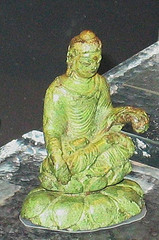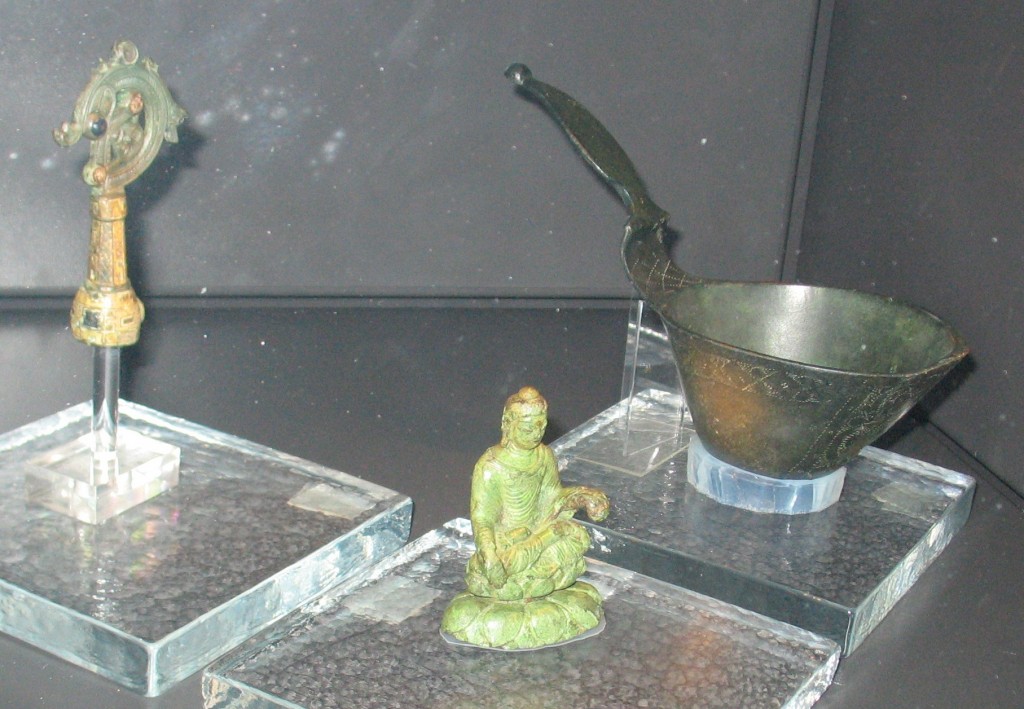The Buddha in Viking Sweden August 20, 2010
Author: Beach Combing | in : Medieval , trackback
Beachcombing thought that today he would revisit a classic anomalous archaeological find: the Helgö Buddha. Knowing though his personal weaknesses, he first did some deep breathing exercises before the mirror repeating a score of times: ‘be nice about the Vikings’, ‘be nice about the Vikings’, ‘be nice about the Vikings’…
Helgö, for those not familiar with Sweden or the bizarre fringes of archaeology, is an island in Lake Mälaren in the south-east of the peninsula. In the Viking Age Mälaren was a fiord and all kinds of delectable goodies arrived here from Viking ‘adventures’ – Beachcombing is straining to use polite words – abroad.
In 1954 excavations began at an early medieval farm on the island, a farm that was still being used as late as the Viking Age and an extraordinary array of objects were retrieved by assiduous trowels.
An Egyptian ladle, A Byzantine bowl, an Irish crozier and, then, the prize, a small ten centimetre high Buddha statuette (see above).
The face is finely drawn with elbows and mouth inlaid with dark substance: eyes inlaid with turquoise and on the right eye an irregular red colour; caste-mark of gold in the middle of the forehead; the ears have much drawn down lobes; the hair is ring punched and at the very top a small semi-globular calotte is placed; the neck has two parallel furrows (fat calluses)… The back has been more summarily modelled. An extra plate with holes at the neck. an indication of a tap between the shoulders and a riveting hole at the foot of the back of the lotus throne indicate that the figure has leant against a decorated backpiece.
Experts have now come to a consensus that the statue was made in the sixth century in North-western India, probably in the Swat Valley.
In some way or other then, and over two or perhaps three hundred years, this little Buddha made its way half way across Euro-Asia to end up on the mantelpiece of a Swedish burgher. Doubtless he sometimes called his wife over and they looked together, shaking their heads at the ‘caste-mark of gold’ on this strange doll’s forehead.
The find has understandably led to much excitement and rather less justifiably claims that Buddhist missionaries had penetrated the Baltic! This is inherently unlikely – Beachcombing can feel a novel coming on.
Nor should we be distracted by claims that some early Scandinavian carvings have gods in what look like lotus postures. Though Beachcombing concedes that if ever a people needed a heavy dose of Buddhism it was the Scandinavians, c. 800, with the Viking itch upon them. Beachcombing can feel a counter-factual novel coming on.
Alternatively some passionate Viko-philes (horrible word) have suggested a Viking raid into Kashmere – the figure, after all, seems to have been torn from a backpiece (see above). This too is – pace the later Vangarian guards – on the dark side of the possible. Though the Vikings did, as a matter of record, pass far up river valleys in the Mediterranean and deep into what is today Russia. The bastards!
Presumably the object was traded down the Silk Road to the Black Sea and from there up the Baltic or just possibly from India to the Caspian and up the Volga to Moscow and from there to the ‘Viking Sea’? That it was found with objects from Egypt, Ireland and the Eastern Mediterranean is, any case, a reminder of just how far Scandinavian ‘traders’ – again Beachcombing is trying to be polite – travelled in the early Middle Ages.
Put together with the dubious but fascinating Viking finds in the eastern US we have trade routes that cover literally a third of the globe.
Beachcombing is always interested in Asian items in early medieval Europe: drbeachcombing AT yahoo DOT com
31 Oct 2013: Lucifer’s Own writes in: in refrence to buddha in sweden i doubt it being stolen more than likely traded for since much of india iran most of asia the vikings peddled their wares peacefully to northeren india in search of crucible steel which they were extremely fond of since all crucible steel was traded for (and this is where the story gets weirder as it goes) various good strongly desired by its asian steel exporters once obtained this high grade steel was taken to frankish kingdom to be forged by catholic sword smiths +vlfbert+ which i surmise quite a alot of coin traded hands to forge this asian steel into pagan weapon to curry favor and protection of said catholics against pagans known to plauge them these ulfbert swords many that still exsist are infact metalirguically tested for origin and indeed are asian in origin and by same maker or from same makers shop several of years apart i suspect this buddah was a bauble for the misses on a return trip one must always bring back something for lady of the house and what more appropriate than a gift of peace and harmony within violent viking home ,i suspect they were after the higher grade iranian and indian wootz or patteren welded steel but accepted a greater alternative since this steel was not easily forged unless you were a master of masters to even begin to forge such a weapon of unnatural strenght and power your rolls royce of killing implements. Asian steel forged by catholics for pagans for defence angainst pagans and a buddah to boot for the misses their is a youtube video which explains it all it will greatly explain the vast trade that went on and the paticulars very intresting sword forgeing going on gives a better insight into the much misunderstood and horrible bad press given relatives of mine i belive the nova produced clip on youtube is called secrets of the viking sword very interesting….’ Thanks LO!
10 Dec 2014 Beach came across this photo of the three main religious finds from Helgo, an Irish crozier, a coptic spoon and the buddha.




